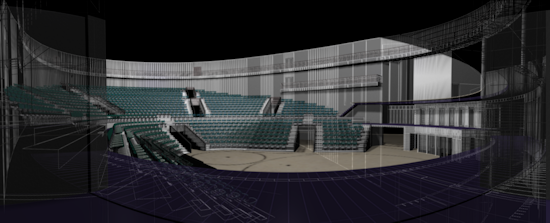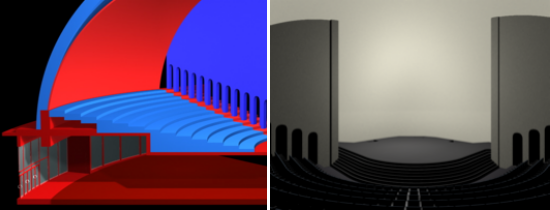|
3DVisA Resources
3DVisA Index of 3D Projects: Theatre Studies
Unrealised Theatre Architecture from the 1920s and 1930s
Keywords: theatre design, Walter Gropius, Norman Bel Geddes, Frederick Kiesler, Norman Meyerhold, visualisation, 3D model, 3ds Max, paradata, authenticity, transparency, credibility.
Throughout the 1920s and 1930s European architects, designers and theatre practitioners became increasingly frustrated with the limiting effect that the ubiquitous proscenium arch theatre had on their ambitions for theatrical experimentation.
Their solution was to dismantle the symbolic structures of the oppressive bourgeois past – the boxes, gallery, and raised stage – and replace this with an arrangement that encouraged
spatial experimentation and social unification. Though not so revolutionary as to reject the notion of a permanent performance venue altogether, the visionary designs,
that this project is focused upon, echo the prevailing ideologies and artistic manifestos of the era. The theatre building itself was to be seen as more than a passive shell;
it would be an active ingredient in the development of a new performance style and a symbol for an Utopian future: a site for an artistic revolution, a cathedral for a humanistic
age.

Fig. 1. The Rachel Hann Interpretation of the new Meyerhold Theatre, Third Variant (1933 – 38) © Rachel Hann 2008 and University of Leeds. Reproduced with kind permission.
This study is based on the investigation of four architectural designs:
Norman Bel Geddes's Theatre Number 6 (incubation period 1914–1929);
Frederick Kiesler's The Endless Theatre (1916–1926);
Erwin Piscator and Walter Gropius's Total Theatre (1926–1934);
Vsevolod Meyerhold's new Meyerhold Theatre (1930–1938).
Today, these Utopian designs offer a fascinating glimpse into the theatrical possibilities they engender. Yet due to their incomplete status – a result of the social and economic upheaval of the 1930s – the performative potential of these spaces remains frustratingly elusive.
Their unconventional arrangements have influenced modern theatre design, seen as key experiments in the search for a flexible but permanent theatre architecture. The various materials that remain on these designs include architectural plans, sketches, and of course written accounts on the principles behind these ambitious structures. Nevertheless, there are significant ‘gaps’ in this material, an absence of information that has ultimately limited the potential for a detailed historical analysis.
The advent of computer-based three-dimensional visualisation has offered us the chance to re-articulate the surviving material into a form of expression that mimics, rather than represents, the intended structural form. Therefore, this study seeks to examine the qualities of this research method and, through the investigation of the above theatre designs, reflect upon the ‘state of knowledge’ that the resulting visualisations represent. With a focus on the procedural over the product, the underlying objective of
the project is to decipher a strategy for unlocking the rigorous activities that bore the visualisation, while still retaining the experiential qualities of the medium.

Fig. 2. An Investigative Visualisation of Norman Bel Geddes's Theatre Number 6 (1914–1929) © Rachel Hann 2007 and University of Leeds. Reproduced with kind permission.
This project also seeks to scrutinise the process of visualisation, through an analysis of the influence of subjectivity and the seductive nature of the intuitive software. This is particularly concerned with the influence of 'dependency relationship',
as defined by the London Charter (2008), and how the medium itself has the potential to assist the formulation, and validation, of a hypothesised third dimension. This methodological argument is focused on the ‘playful’ nature of the virtual material and the limitless manipulation/experimentation facilitated by the software interface. This may be seen as the medium's provocative invitation to historians to, at times literally, ‘fill in the gaps’ and provisionally complete the incomplete. Additionally, the impact of the London Charter is by no means limited to this section of the project, as its recommendations form the basis the project’s methodological strategy, as well as providing a standard set of working terminologies.
![The Hann Interpretation of Kiesler's Endless Theatre, 1923-26]()
Fig. 3. The Rachel Hann Interpretation of Frederick Kiesler's Endless Theatre (1923–1926) (Ongoing) © Rachel Hann 2009 and University of Leeds. Reproduced with kind permission.
The interpretative decisions taken by the researcher, along with the provisional status of the visualised material, will be accessible through a variety of different methods. Although accessibility is not a primary research aim, in order to evidence the research findings the issue of documentation, and the navigation of this material, becomes an essential concern. This tension between knowledge generation and knowledge presentation has informed and evolved the choice of visualisation strategy, with the investigation of each case study examining the subject through a chosen methodological approach. These are broken down into two main categories, presentational methodologies and procedural documentation.
|
The complexity of the interpretative process, and our perception of the material, will ultimately lead to a blurring of these groupings.
There are plans to develop this project still further. This will focus on the impact of abstracted presentational strategies on the relative 'credibility' of the information and the development of procedural working guidelines for working with unrealized structures. This will be supported by further investigative visualizations on other lost or unrealised performance venues/structures.
Software: Autodesk’s 3ds Max 2008
Project dates: The project is part of doctoral research due for completion in September 2009.
Resource status: There is currently (April 2009) a dissemination website in development, which will present both the visualised material and its associated procedural documentation.
Contributor: Rachel Hann is a Ph.D. candidate at the School of Performance and Cultural Industries, University of Leeds, UK.
Bibliography:
Bel Geddes, N. (1932), Horizons. Boston: Little, Brown. Reprinted 1978, Dover Publications Inc.
Braun, E. (trans.) (1972), 'A Theatre for Meyerhold', Theatre Quarterly 2, 7: 69-73.
Gropius, W. and Wensinger, A. S. (eds.) (1961), The Theatre of the Bauhaus, Middletown, Conn.: Wesleyan University Press. Reprinted 1996, Baltimore: Johns Hopkins University Press.
Held, R.L. (1982), Endless Innovations: Frederick Kiesler's Theory and Scenic Design, Ann Arbor: UMI Research Press.
Record kindly provided by Rachel Hann, 3 April 2009. Last updated: 14 April 2009.
© Rachel Hann and 3DVisA, 2009.
Back to the list of 3D projects
|
